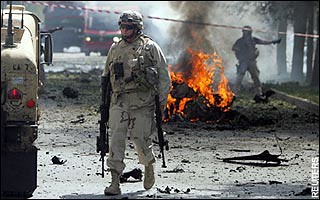(NSI News Source Info) December  23, 2008: Hamas is at war with Israel, but tries to portray itself as a victim of "Israeli aggression" to its Moslem and leftist allies around the world. Inside Gaza, Hamas lets its pro-war propaganda run full bore in Arabic. A more nuanced message is broadcast in non-Arabic media.
23, 2008: Hamas is at war with Israel, but tries to portray itself as a victim of "Israeli aggression" to its Moslem and leftist allies around the world. Inside Gaza, Hamas lets its pro-war propaganda run full bore in Arabic. A more nuanced message is broadcast in non-Arabic media.
 23, 2008: Hamas is at war with Israel, but tries to portray itself as a victim of "Israeli aggression" to its Moslem and leftist allies around the world. Inside Gaza, Hamas lets its pro-war propaganda run full bore in Arabic. A more nuanced message is broadcast in non-Arabic media.
23, 2008: Hamas is at war with Israel, but tries to portray itself as a victim of "Israeli aggression" to its Moslem and leftist allies around the world. Inside Gaza, Hamas lets its pro-war propaganda run full bore in Arabic. A more nuanced message is broadcast in non-Arabic media. Every day, Hamas undertakes military operations. Along the security fence, snipers and bomb planting teams operate. The bombs and snipers are used against Israeli patrols, and are trying to force Israeli forces away from the fence, so that Hamas terrorists can breach it and get into Israel.
Failing that, Hamas hopes to inflict casualties on Israeli forces. In northern Gaza, rockets and mortar shells are still fired into sparsely populated southern Israel. The mortars are also used to fire at Israeli military installations along the security fence.
Along the Egyptian border, Hamas threatens violence if the Egyptian security forces get too aggressive in shutting down the smuggling tunnels that bring weapons and consumer goods in.
Many Gazans oppose Hamas, and its warlike stance, there's not much they can do about it. Hamas has set up a police state that would require a bloody revolution to remove. Hamas is also propelled by religious fanaticism (the worldwide Islamic religious dictatorship that al Qaeda and Iran yearn for).
People with guns, who are on a Mission From God, are difficult to negotiate with. Israel has to seriously consider a military operation to remove Hamas. Israel can do this, but it would be very bloody, with thousands of Palestinians, and hundreds of Israeli, dead. There would have to be some large prison camps to hold all the Hamas activists, and problems with finding enough Fatah members to run an Israeli occupied Gaza. That would, however, stop the rockets and mortars. But a military solution to Gaza would temporarily increase the rocket fire. Previously, Hamas has not been able to fire more than 60 rockets a day.
But since the Hamas buildup during the ceasefire, it is believed that Hamas could more than triple that, for a few days, in the midst of an invasion. Then the rockets would decline to hardly any.
Hamas has been building a supply of rockets, with a goal of being able to make a mass attack, like the one Hezbollah did in northern Israel in 2006. Over 4,000 rockets fell in Israel during that offensive, and Hamas believes something similar in the south would do something useful for their cause. Hamas planners missed the point that Hezbollah lost much, and gained little, because of their 2006 war.
Actually, some Hamas strategists sense that mass rocket attacks will do little for them, and are trying to figure out how to renew suicide bombing attacks inside Israel. These have been reduced to practically nothing because of Israeli security measures.
In the face of this, Hamas declared, three years ago, that it was halting suicide bombing attacks. Just announcing a renewal of suicide bombings could be embarrassing if nothing happened. But Hamas does have resources, even in the West Bank, to give it a try.
One advantage Israel would have in Gaza is the lack of any adjacent sanctuary for the Hamas fighters. Egypt is hostile to Hamas (because of support for Islamic terrorists operating against Egypt.) Israeli military plans basically turn Gaza into one big prison camp. This would be expensive to operate, and cause even more diplomatic problems.
Despite Palestinian terrorism and refusal to make peace, leftists (in government, academia and the media) worldwide have long followed the lead of the defunct Soviet Union, and simply designated Israel as the aggressor. Endemic anti-Semitism (temporarily suppressed by the aftertaste of World War II) in Europe made it easy for non-Jews, but especially leftists, to come down hard on anything Israel did.
Israel does not have many options here. As long as Hamas preaches, and prepares for, all-out war, a military response has to be considered. Hamas isn't using any recognizable (in the West) logic here. They consider themselves commissioned by God to destroy Israel, and no arguments can sway them from those orders.
The counter-terrorism campaign continues in the West Bank, where several Palestinian terrorist groups continue to work on carrying out attacks inside Israel. The new Fatah government has been more helpful, so Israeli police continue to detect and arrest Palestinian terrorists before they can accomplish much.
December 21, 2008: A Palestinian rocket landed in the Israeli city of Ashkelon, a city of about 120,000 on the coast 16 kilometers north of Gaza. There were no casualties, but this was more evidence of the increasing number of longer range rockets Hamas was building or smuggling into, Gaza. Today, 19 rockets and three mortar shells were fired into Israel from Gaza.
December 20, 2008: Palestinians in Gaza fired 13 rockets and 20 mortar shells into southern Israel. In response, Israel is going to undertake more aggressive air and artillery attacks on rocket workshops, storage areas and launch sites. Many parts of Gaza are under 24/7 UAV observation, and Israel knows a lot about the Hamas rocket production, storage and launching operation. Most of this activity takes place in residential areas, to insure civilian casualties if Hamas operations are attacked. Meanwhile, in Egypt, a fuel truck caught fire and exploded as it was unloading 12,000 gallons of fuel for smugglers (who took it into Gaza via tunnels). Last month, police seized a truck carrying 40,000 gallons in the same area, also destined for Gaza via the tunnels.
December 19, 2008: Hamas refused to renew the six month truce with Israel, which expires today. In practice, the ceasefire, brokered by Egypt, was more of a reduced fire arrangement. In return, Hamas expected more supplies to flow into Gaza. Hamas says it did not renew because it did not get as many supplies as it had expected. This was because Israel still shut down the crossings when more than a few rockets or mortar shells came into Israel from Gaza. Palestinians fired twenty rockets into southern Israel today, wounding three civilians.


































